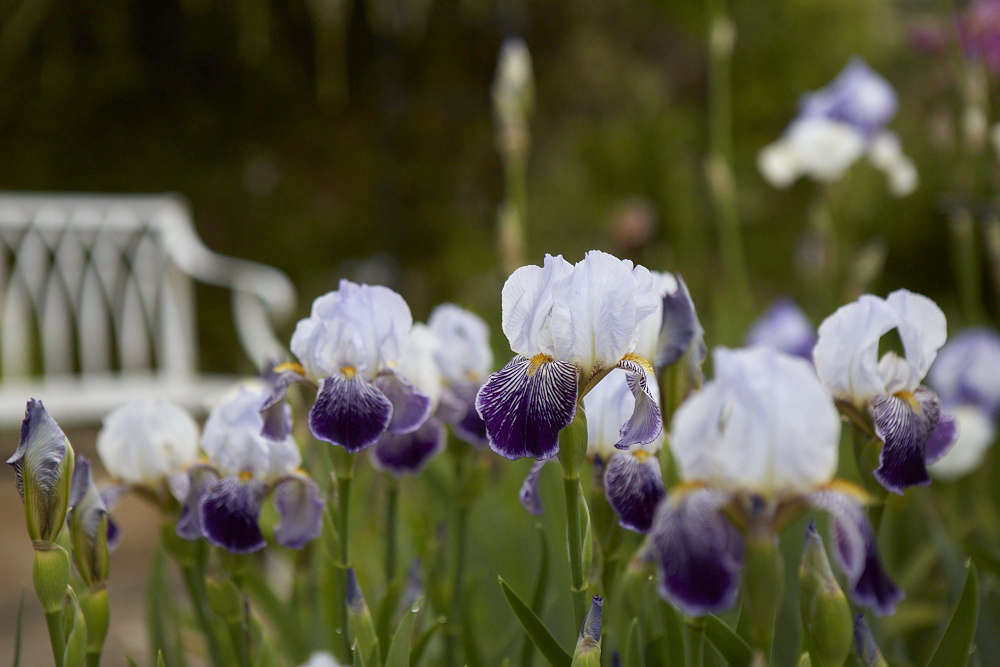

Bliss irises, developed during or just after World War One, belong to the Lost Generation.
Bliss irises, developed during or just after World War One, belong to the Lost Generation.
Photography by Britt Willoughby Dyer, for Gardenista.
Photography by Britt Willoughby Dyer, for Gardenista.
Bliss, a highly regarded iris breeder whose deafness kept him out of the war, developed varieties that are not only pleasantly dated in color, they also have simpler and more dignified shapes than some newer varieties seen at shows.
Bliss, a highly regarded iris breeder whose deafness kept him out of the war, developed varieties that are not only pleasantly dated in color, they also have simpler and more dignified shapes than some newer varieties seen at shows.
Along with Sarah Cook and her national collection of Cedric Morris irises, developed over the last two decades, Anne Milner’s collection of Bliss irises are a bridge to the past.
Along with Sarah Cook and her national collection of Cedric Morris irises, developed over the last two decades, Anne Milner’s collection of Bliss irises are a bridge to the past.
Above, from left: ‘Hester Prynne’ (1929), ‘Duke of Bedford’ (1922), ‘Camelot’ (1918), all bred, or in the case of Camelot—thought to have been bred—by Arthur Bliss in Devon.
Above, from left: ‘Hester Prynne’ (1929), ‘Duke of Bedford’ (1922), ‘Camelot’ (1918), all bred, or in the case of Camelot—thought to have been bred—by Arthur Bliss in Devon.
The Historic Iris Preservation Society has been instrumental in keeping the progeny of early 20th centuries in the plant catalogs and is a good resource for tracking down heirloom varieties.
The Historic Iris Preservation Society has been instrumental in keeping the progeny of early 20th centuries in the plant catalogs and is a good resource for tracking down heirloom varieties.
A closer look at Bliss iris ‘Hester Prynne’. For the background on Cedric Morris and his irises of the 1940s and ’50s, see: The Mystery of the Missing Irises: Have You Seen Any of these Varieties?.
A closer look at Bliss iris ‘Hester Prynne’. For the background on Cedric Morris and his irises of the 1940s and ’50s, see: The Mystery of the Missing Irises: Have You Seen Any of these Varieties?.
The collection of Bliss irises overseen by Anne Milner is not complete but is slowly growing.
The collection of Bliss irises overseen by Anne Milner is not complete but is slowly growing.
Bliss irises, Gloucestershire. For more of Vita’s thoughts, see: Required Reading: Vita Sackville-West’s Sissinghurst.
Bliss irises, Gloucestershire. For more of Vita’s thoughts, see: Required Reading: Vita Sackville-West’s Sissinghurst.
Iris ‘Marsh Marigold’ 1919.
Iris ‘Marsh Marigold’ 1919.
Margery Fish again, in the indispensable book We Made a Garden, notes: “The foliage of irises is so beautiful at all times that a clump here and there among other plants is a great help in creating a harmonious planting.”
Margery Fish again, in the indispensable book We Made a Garden, notes: “The foliage of irises is so beautiful at all times that a clump here and there among other plants is a great help in creating a harmonious planting.”
Iris ‘Evadne’ from 1921.
Iris ‘Evadne’ from 1921.
‘Bruno’ from 1922, probably. Small amounts of Bliss irises are available from Anne Milner; see the Bliss Irises site for details.
‘Bruno’ from 1922, probably. Small amounts of Bliss irises are available from Anne Milner; see the Bliss Irises site for details.


